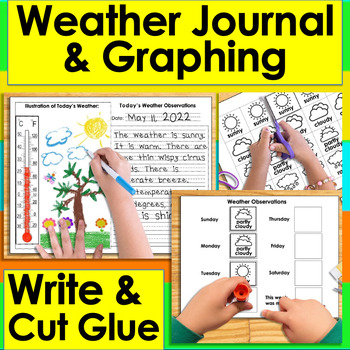Weather Journal with Weather Chart, Graphing & Writing Integrated Differentiated
- PDF
What educators are saying
Also included in
- Use these 3 weather products to teach your younger learners about weather!1) Weather Journal: Writing, Illustrating, Graphing2) Weather Mini Books: 3 Reading Levels - Color and Blackline - Illustrated Word Wall 3) Weather PowerPoint Presentation - 3 Levels + VocabularyNEXT GENERATION SCIENCE SPrice $8.45Original Price $11.45Save $3.00
Description
This kindergarten and first grade differentiated Weather Journal includes a Weather Chart and Weather Graphing with Questions, as well as Weather Observations for integration of math, science and writing!
❤️❤️ Differentiated versions including a cut and glue version for younger learners.
✍❤️ Write across the curriculum and integrate math, writing and weather graphing as students learn about weather!
4 Writing Style versions: skip count or simple baselines. Text box at side or bottom.
Contents:
✅ 4 choices of covers ready to be colored by students
✅ 4 choices of Weather journal pages with date, thermometer to color in,
a box for an illustration and a text box with choice of baselines or simple lines
for recording weather
✅ 4 Pages of Pictures of weather for cut and glue (color & BW): sunny,
partly cloudy, cloudy, rainy, snowy, stormy, windy, mostly cloudy
✅ Weather Graphing Pages
✅ Weather Questions to Complete
NEXT GENERATION SCIENCE STANDARDS
K-ESS2-1
Use and share observations of local weather conditions to describe patterns over time. Examples of qualitative observations could include descriptions of the weather (such as sunny, cloudy, rainy, and warm); examples of quantitative observations could include numbers of sunny, windy, and rainy days in a month. Examples of patterns could include that it is usually cooler in the morning than in the afternoon and the number of sunny days versus cloudy days in different months. Assessment of quantitative observations limited to whole numbers and relative measures such as warmer/cooler.
K-ESS3-2
Ask questions to obtain information about the purpose of weather forecasting to prepare for, and respond to, severe weather. Emphasis is on local forms of severe weather.
COMMON CORE STANDARDS
K.CC.B.5
Count to answer “how many?” questions about as many as 20 things arranged in a line, a rectangular array, or a circle, or as many as 10 things in a scattered configuration; given a number from 1-20, count out that many objects.
1.MD.C.4
Organize, represent, and interpret data with up to three categories; ask and answer questions about the total number of data points, how many in each category, and how many more or less are in one category than in another.






